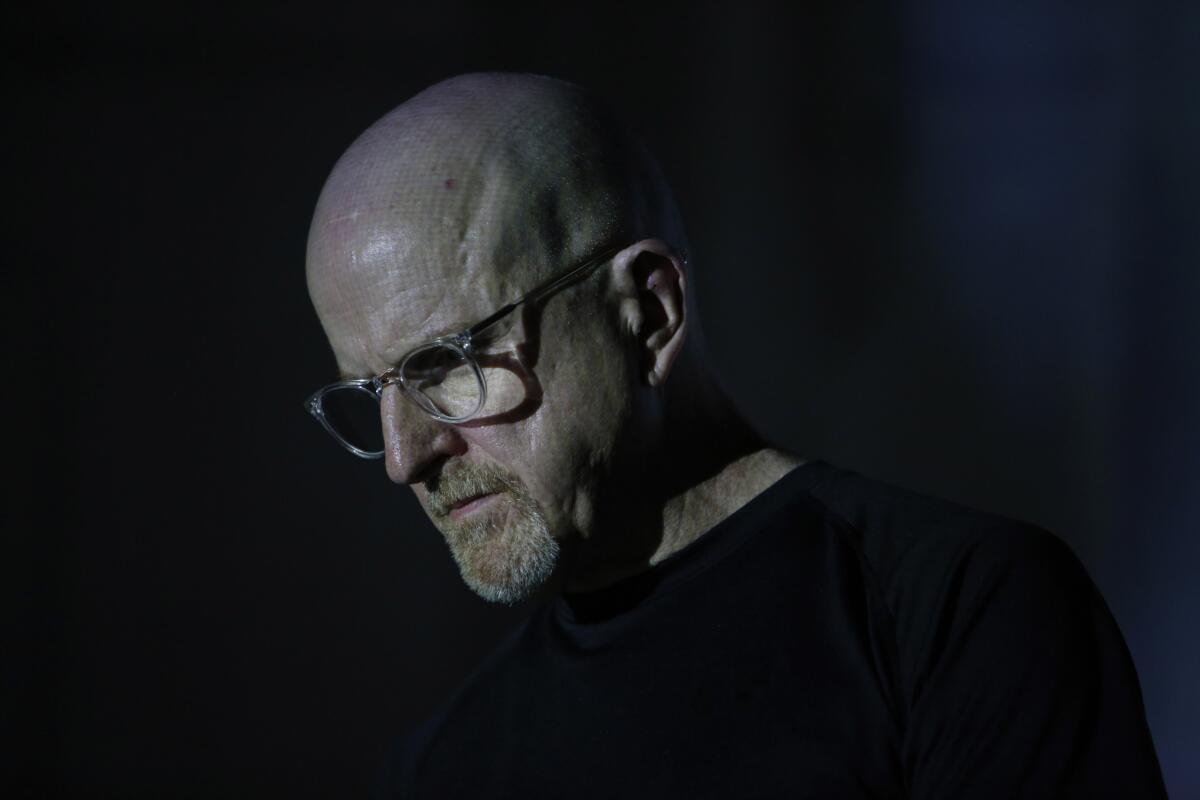Review: Lustmord, Grouper explore noise and texture in deep Masonic Lodge set

Standing beneath the all-seeing Masonic pyramid symbol called the Eye of Providence, the artist who records as Lustmord made his Los Angeles debut after three decades as a preeminent sculptor of dark, stomach-rumbling sonic design and experimental aural incantation.
So thick was the sound within the Masonic Lodge’s cavernous space, it’s a wonder the room’s dim chandelier bulbs didn’t burst, the lead holding the stained glass didn’t liquefy or Gozer the Destructor (or L. Ron Hubbard) didn’t roar back from the great beyond.
As Lustmord, the moniker of the artist born Brian Williams, delivered pieces from his vast body of work across the hourlong set, projections of smoke and flames burst in symmetric patterns around him. Ancient symbols -- twelve-pointed stars etched, mysterious texts -- floated across the wall, offering visual accompaniment. A multimedia manifestation of Mike Huckabee’s worst fears of California, basically.
It started just after midnight, the last of four performances on Saturday evening at the mystical lodge, located within Hollywood Forever Cemetery, that reveled in mostly beatless textures.
Williams has spent his life working with frequencies as painters do with oils, helping to define what in experimental music circles has come to be known as dark ambient music. Although he has lived in Los Angeles for more than two decades crafting aural drama as a sound designer (“The Crow,” “Tank Girl,” “From Dusk Til Dawn,” and many others), he had never performed here in public, and he had played only two times in America this century.
An artist able to have intelligent conversations about death frequencies -- those so said to be so sonically overwhelming that they can kill -- and the so-called brown notes that cause involuntary bodily functions, Williams on Saturday delivered work that resided at the intersection of sound design, noise, music, sonic warfare and silence.
It was a momentous descent into an abyss, a terrain he’s helped map. Harnessing Brian Eno’s ideas about crafting music for background instead of foreground, Williams started in early 1980s Britain carving a more aggressive path, one in which tones were generated not for ambient relaxation but to explore darker corners and grimmer sensations. If Eno’s “Music for Airports” traded in pleasurably mundane tones and arrangements, Lustmord’s work on Saturday, and throughout his career, felt culled from ancient catacombs and designed for maximum psychic disturbance.
Over the decades he’s collaborated with artists including Throbbing Gristle’s Chris & Cosey, industrial group SPK, avant-metal band Tool, sludge-rock band the Melvins and composers Graeme Revell, Robert Rich and Monte Cazazza. In essence, souls for whom the understood ingredients for creating music, steady rhythm and sticky melody are not only mostly ignored but actively negated.
Awash in the glow of the projections covering the huge white wall behind him, the Wales-born artist presented eardrum rumbling tone-layers that moved through the venue as though conjured by incantation. Part improvisation, part designed with earlier work woven in, Williams seamlessly merged old and new.
“Aldebaran of the Hyades” welded tones both human and mechanical, synthesizing man-moans and industrial-strength clang and din. As swooshes of staticked hiss floated in and out as though in orbit, high-pitched radar tones seeped in. Both a chant and a descent, the work felt less a composition than an aural spell.
Perhaps most striking, though, was the miraculous sensation Williams was able to conjure. For much of the hour, sheets of deep, complex frequencies so consumed the space that it became a kind of silence, a wash of low and midrange texture that roared through the room with a focused consistency. In the middle of such a din, sound waves from outside that realm whipped through like bolts of lightning on a distant horizon.
Before Lustmord’s nearly hourlong set, the artist who performs as Grouper presented a more delicate, harmonious exploration. Her real name is Liz Harris, and she harnessed a traditional instrument, the guitar, to build works filled with equally wild wave forms both real and synthesized.
During a set that moved from one work to another minus any breaks, Harris sat onstage before a dozen-odd effects pedals and worked strums, feedback, loops, layers and much mysterious interminglings. Two of her most recent songs, “Holding” and “Clearing,” drifted through the lodge with a physicality, her voice seeping in, gaining strength as she layered it to seem like hundreds.
After an opening set by a trio called Tropic of Cancer, the Berlin sound sculptor Alexander Lewis shot forth more abrasive, in-your-face textures while a dusty clip of a man climbing a ladder looped above. Like Sisyphus with his boulder, each time the climber reached the top rung, he looped to start anew.
To many music lovers wedded to beats and melodies, four hours worth of the brand of untethered, often abrasive noise like that heard in the cemetery would be torturous. But to others, the hurts-so-good vibrations that hummed through the Masonic Lodge left psychic marks that seem as permanent as tattoos.
Looking for music tips? Follow Randall Roberts on Twitter: @liledit
More to Read
The biggest entertainment stories
Get our big stories about Hollywood, film, television, music, arts, culture and more right in your inbox as soon as they publish.
You may occasionally receive promotional content from the Los Angeles Times.











